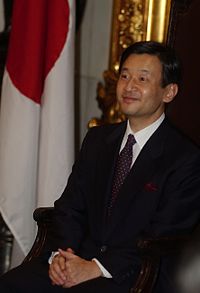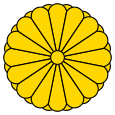Naruhito, Crown Prince of Japan
| Naruhito 徳仁皇太子 |
|
|---|---|
| Crown Prince of Japan | |
 |
|
| Spouse | Masako, Crown Princess of Japan |
| Issue | |
| Aiko, Princess Toshi | |
| Titles and styles | |
| HIH The Crown Prince of Japan HIH Prince Hiro |
|
| Father | Emperor Akihito |
| Mother | Empress Michiko |
| Born | February 23, 1960 Togu Palace, Tokyo |
Naruhito, Crown Prince of Japan (徳仁皇太子 Naruhito Kōtaishi?) (born February 23 1960) is the eldest son of Emperor Akihito and Empress Michiko, which makes him the heir apparent to the Chrysanthemum Throne of Japan. The Crown Prince is well known for his extensive charity work.
Contents |
Early life and education
Titled Prince Hiro (浩宮 Hiro-no-miya?) as a child, he was invested as the Crown Prince on 23rd February, 1991,[1] follwing the death of his grandfather, Emperor Showa on January 7 1989.
He received bachelor's and master's degrees in history from Gakushuin University in 1982 and 1988, respectively. In 1983-85 he studied in England at Merton College, Oxford.
Prince Naruhito plays the viola and practices jogging, hiking, and mountaineering in his spare time. He has written several papers and a memoir of his Oxford days, The Thames And I: A Memoir Of Two Years At Oxford (ISBN 1-905246-06-4).
Marriage and issue
The Prince pursued and eventually proposed (reportedly twice) to the then 29-year-old Masako Owada, a diplomat in the Japanese Foreign Ministry working under her father Hisashi Owada who is currently judge on the International Court of Justice, former vice minister for foreign affairs and former Japanese ambassador to the United Nations. The Imperial Palace announced their engagement on 19 January 1993.
On June 9 1993, The Crown Prince of Japan and Masako Owada were married at the Imperial Shinto Hall in Tokyo before 800 invited guests and an estimated media audience of 500 million people around the world. Many of Europe's crowned heads attended. So, too, did most of Europe's elected heads of state. The couple make their home at the Tōgū Palace, on the Akasaka Estate in Minato, Tokyo.
Naruhito has one daughter from his marriage:
- Aiko, Princess Toshi, born 1 December, 2001.
Imperial succession controversy
|
|
 |
|
HIM The Emperor
|
Aiko's birth, which occurred more than eight years after their marriage, sparked lively debate in Japan about whether the The Imperial Household Law of 1947 should be changed from that of agnatic (i.e. male-only) primogeniture to equal primogeniture, which would allow a woman to ascend to the Chrysanthemum Throne.
A government-appointed panel of experts submitted a report on October 25 2005, recommending that the Imperial succession law be amended to permit equal primogeniture. On January 20 2006, former Prime Minister Junichiro Koizumi used part of his annual keynote speech to address the controversy when he pledged to submit a bill to the Diet letting women ascend to the throne in order that the imperial throne be continued into the future in a stable manner. Koizumi did not announce a timing for the legislation to be introduced nor did he provide details about the content but he did note that it would be in line with the conclusions of the 2005 government panel.
On September 6 2006, at 8:27 a.m. (Japan Standard Time), Princess Kiko gave birth to a son, Hisahito, who is third in line to the Chrysanthemum Throne under the current law, after his uncle, the Crown Prince and his father, Prince Akishino. The prince's birth not only provided the first male child to be born in the imperial family for 41 years, but could also mean plans to allow female succession will not go through.
Masako controversy
On July 11, 2008, Naruhito sought public understanding for his wife, who was suffering from a stress-induced form of depression, diagnosed as an adjustment disorder. "I would like [the public] to understand that Masako is continuing to make her utmost efforts with the help of those around her. Please continue to watch over her kindly and over the long-term." Pressures to produce a male heir, to conform with the ancient traditions and a 1947 imperial law, were perceived to be behind her illness.[2][3]
Personal interests
His Imperial Highness is an enthusiastic sportsman and music lover, being an avid tennis player ; he also enjoys mountaineering and jogging. He is an accomplished violist.
Naruhito is also interested in water policy and water conservation. With regard to water issues, in March 2003, in his capacity as Honorary President of the 3rd World Water Forum, he delivered a memorial speech at the opening ceremony of the Forum entitled, "Waterways Connecting Kyoto and Local Regions". On the occasion of his visit to Mexico in March 2006, he delivered the keynote address at the opening ceremony of the 4th World Water Forum entitled, "Edo and Water Transport." In addition, in December 2007, he delivered the commemorative lecture at the opening ceremony of the 1st Asia-Pacific Water Summit, entitled "Humans and Water: From Japan to the Asia-Pacific Region."[4]
Official duties

| Styles of The Crown Prince of Japan |
|
 |
|
| Reference style | His Imperial Highness |
|---|---|
| Spoken style | Your Imperial Highness |
| Alternative style | Sir |
Crown Prince Naruhito is an honorary member of the World Commission on Water for the 21st Century and patron of the Global Water Partnership, a body established by the World Bank, the United Nations, and the Swedish Agency of Development.
The prince is a member of the Council of State, the highest council to the Japanese government that is chaired by his father, Emperor Akihito. As part of his Royal duties, he holds commissions in the Japanese Army, Navy and Air Force, and was a patron of the Japanese Olympic Games Committee until 1998 when he was made a member of the International Olympic Committee. On behalf of the Crown, the Prince carries out various representative duties both within Japan and abroad. The Prince is also the supporter of the World Organisation of the Scout Movement and in 2006 attended the 14th Nippon Jamboree, which is the Japanese national jamboree organized by the Boy Scout Association of Japan. The Crown Prince is also honorary Vice-President of the Japanese Red Cross Society since 1994[5].
Notes
- ↑ http://www.kunaicho.go.jp/e02/ed02-04.html Kunaicho.go.jp, the Imperial Household Agency website, retrieved 4th December, 2008
- ↑ ukpress.google.com, Crown prince defends ailing wife
- ↑ gmanews.tv/story, Japan's crown prince seeks public understanding for ailing princes
- ↑ http://www.kunaicho.go.jp/e03/ed03-03.html Imperial Household Agency official website, retrieved 4th December, 2008
- ↑ http://www.kunaicho.go.jp/e03/ed03-03.html, Imperial Household Agency offical website, retrieved 4th December, 2008
|
Naruhito, Crown Prince of Japan
Imperial House of Japan
Born: February 23 1960 |
||
| Japanese royalty | ||
|---|---|---|
| Preceded by Akihito Incumbent |
Line of succession to the Japanese throne 1st position |
Succeeded by Prince Akishino |